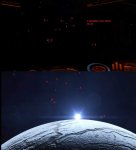In RL we have the (somewhat recent, somewhat surprising) discovery of sulphur & silicon-based life at the edges of deep-sea geological fault planes (the Vents/Trenches).
Nope, we sure haven't.
- - - - - Additional Content Posted / Auto Merge - - - - -
Please describe content and depth.Frontier rely on massively multiplayer grinding to create content that lacks depth.
- - - - - Additional Content Posted / Auto Merge - - - - -
Does anyone know of a way to plot peaks of RGB values from a video against time? When placed up against a surface in the dark, UA's show three distinct light emitters, and they pulse rhythmically. I've recorded a UA, and I've got the RGB's displayed in Adobe Premiere Pro, and I'm going frame by frame recording the millisecond timing of each pulse of light.
So far, it seems that the pulses in blue last .20 milliseconds, 1 second, and 1.5 seconds, and the gaps between the pulses are the same. My understanding is that Morse is built out of these ratios. The problem is, my computer is old, and there are frames missing, so it's sometimes hard to tell precisely when a pulse begins and ends, and there are gaps in my maybe-Morse. A graph would make this much easier, but I'm having trouble finding software capable of it. Plenty can show the RGB of a frame, but not averages over the whole file.
That's brilliant.


